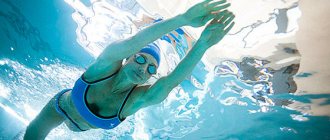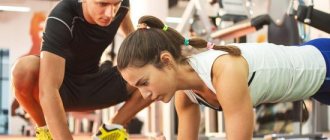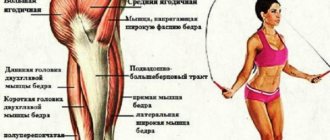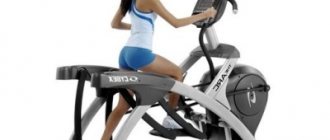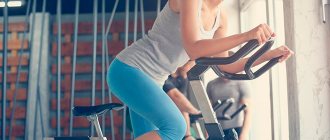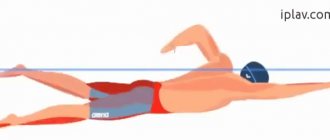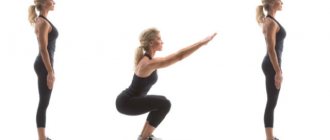Swimming can be a great workout for burning calories and losing weight. For every kilogram of your body weight, swimming burns between 0.1 and 0.14 calories per minute. If you weigh around 150 pounds, you can expect to burn more than 200 calories in 30 minutes. This is a fairly serious figure when compared even with cycling or running at an average pace, and certainly better than walking. Remember that certain swimming strokes, such as butterfly and breaststroke, burn more calories, so choose wisely.
- Swimming burns more calories
- Swimming is a great full body workout
- You burn 446 calories in an hour of swimming.
- Swim for just 30 minutes a few days a week
- The backstroke burns 298 calories and the butterfly burns 409 calories in 30 minutes.
- Swim Mixed to Burn More Calories
- Let's calculate how many calories are burned if you swim 1000 meters Let's figure it out: how long are you actually swimming?
Swimming burns more calories
Previously, we talked about whether it is possible to lose weight by swimming in the pool, this time we will talk about the effectiveness of this type of training for burning in terms of calorie expenditure.
- You burn 446 calories in an hour of swimming.
- Swim for just 30 minutes a few days a week
- Swimming butterfly burns 409 calories in 30 minutes
- Swim Mixed to Burn More Calories
What if I told you that you can burn 400 or all 500 calories without breaking a sweat? Yes, yes, I'm talking about how many calories are lost when swimming! You can burn several hundred calories in just half an hour in the pool - and even more if you choose a more challenging swimming style or increase your pace. Once you learn about the calorie burn of swimming, you may never want to go back to the sweat-soaked land technique again!
There are many reasons to add this full-body workout to your fitness regimen. The time spent in the pool can be used with maximum efficiency. Read on and find out exactly how.
Crawl, breaststroke or butterfly?
First of all, it should be noted that in order to effectively burn calories, in any case, you should swim in the correct technique, with your head in the water .
This is also important for your health, I wrote about it here and here.
If you go to the pool to lose weight, but have doubts about your swimming technique, take at least a few training sessions from a trainer .
As for which style to choose for weight loss, it is worth noting the following:
- The crawl and breaststroke are not very different from each other in terms of calorie burning.. If you are more of a breaststroke swimmer in terms of technique, but are not so good with the freestyle, then faster and more correct breaststroke swimming may well give better results in terms of energy consumption.
Breaststroke - Not only does it take 30 minutes to swim the butterfly stroke, but even for at least 10 minutes continuously, few people can swim. This is a physically very challenging style and is suitable for professionals and advanced swimmers.
In this regard, you should not count on the fact that you will be able to swim continuously for an hour or at least half an hour in the butterfly stroke and thereby burn a lot of calories - this is physically impossible for most pool visitors. On the other hand, butterfly goes well with other styles : you can swim along the pool path in one direction with butterfly, return back on your back, or (if you have enough strength) with crawl or breaststroke. Here we also come to the next point. - As I have written more than once in articles on this site, if you exercise in the pool for health, strengthening muscles, ligaments, and developing endurance, then it is most optimal to combine all swimming styles during training (focusing on one style makes sense when developing technique or when preparing for competitions).
This is due to the fact that different muscle groups are involved in different styles (see separate articles about working muscles in crawl, breaststroke, butterfly, backstroke).
By combining styles, you fully work out your body - this is a unique feature of swimming, not typical of most other sports.At competitions there is a separate discipline that combines all styles - medley swimming. However, it is usually difficult for a physically unprepared swimmer to swim more than 2-3 complexes in a row (primarily due to the presence of butterfly in their composition). It is more realistic to swim freestyle and breaststroke separately, and combine butterfly (if desired and able) with, for example, backstroke – as indicated in point 2 above.
Swimming is a great full body workout
Swimming is a whole exercise program rolled into one, and it's good for you for a variety of reasons.
- Safe Cardio: Cardio is very important in a training program to raise your heart rate. Swimming helps you do this without stressing your joints the way vigorous aerobics or dance-based exercises do.
- Strength Training: In addition to strengthening your cardiovascular system, swimming tones your muscles and helps build strength just like weight training.
- Increased stamina: It also helps improve stamina.
- Increased Lung Capacity: As your endurance improves, your lung capacity also increases.
- Full Body Workout: A full body workout in the truest sense of the word, swimming works almost every muscle in the body, leaving you invigorated and energized.
- Reduces the risk of diabetes, heart disease and stroke: Regular swimming can reduce the risk of developing chronic diseases such as type 2 diabetes, heart disease and even stroke.
- Better load distribution: The New York Times published an article stating that swimmers' bodies are better able to handle stress than runners' bodies. Unlike runners, whose performance decreases the longer the distance they run, swimmers maintain a steady pace even over long distances. In fact, the statistician and swimmer quoted in this article found that competitive swimmers burn 25 percent more calories than runners for the same amount of training time.
- Weight Loss: If that's not enough to get you thinking about swimming, how about the faster weight loss and mood boost that swimming provides?
How to choose a place to swim
Almost every city has several large water sports complexes. Some are used by professional athletes, while others are available for public visitation and use. There are also swimming pools on university campuses and in some schools.
Some tips to help you choose a place to swim:
- Find out about all the available public swimming spots in the city. Compare prices, read reviews;
- Pay attention to sanitary and epidemiological standards - most swimming pools should require a certificate from a doctor stating that the person does not have skin or other diseases;
- If you are going to swim short distances, a 25 meter pool will be enough. If you want to practice professionally, you will need a 50-meter pool;
- Sign up for trial lessons at a few pools you like. Evaluate the interior, water quality, cleanliness of showers and locker rooms;
- If you want to work out with a trainer, call ahead or visit the gym's website to see if they offer personal trainer services. Swimming can also be done in groups.
Swimming is one of the most accessible sports: it does not require special physical training or expensive equipment. Almost anyone can learn to swim. All you need is desire and free time.
In addition to pleasure, swimming improves health, relieves stress and tension and improves mood. By combining business with pleasure, you can simultaneously pump up your muscles, lose weight and become more resilient.
You burn 446 calories in an hour of swimming.
Looking to add swimming to your fitness regime? First, figure out how many calories you burn in an hour or even a short 20-minute swim.
Swimming for 30 minutes burns about 223 calories for the average person weighing about 70 kilograms. Thus, in an hour you will burn 446 calories. This is comparable to a very fast dance or walking over rough terrain. And this is only for swimming at an average pace. Switch to butterfly or breaststroke and those numbers increase even more.
Swimming vs. Walking: Walking at 5.5 km/h will burn 149 calories (versus 223 calories for swimming in the same amount of time). Even if you accelerate to 7 km/h, swimming will still remain ahead - in 30 minutes of such walking you will burn just over 180 calories.
Comparison of swimming in terms of energy consumption with other sports
Swimming is the only sport that uses all muscle groups at once. An hour-long workout in the pool, which brings moral pleasure and a sense of self-satisfaction, is in no way inferior, and in some cases even surpasses common sports on land in terms of energy consumption.
Run
Running is considered one of the most popular ways to lose weight; an hour-long session leads to a loss of 300-550 kcal. But this sport has many contraindications and is difficult for people with excess weight, pathologies of the cardiovascular, musculoskeletal and respiratory systems. Swimming is recommended for almost all people; loads in water are much easier to bear than on land.
Bike
Cycling, in addition to improving health, broadens your horizons and promotes weight loss; in an hour of intense training, the body can burn up to 700 kcal. But not all muscles of the body are involved in this sport; cycling is not always convenient for the elderly and people with a lot of weight. Calorie consumption begins only after 30-50 minutes of fast riding, which requires sufficient distance and a lot of training time.
Walking
Walking is recommended for people who are unable to run or go to the gym. Any walk is good for the body, but calorie consumption is observed only when walking quickly for a long time and following a diet so that the amount of energy consumed is greater than the calories consumed. Race walking at a speed of 9 km/h leads to burning from 600 to 900 kcal per hour, depending on body weight. Such a dynamic way to improve health is beyond the power of many people.
Water aerobics
Water aerobics is a close relative of swimming. Depending on weight and rhythm, up to 700 kcal are burned per hour due to the high resistance of water. Heavy rhythmic exercise is made relatively easy by performing all exercises in water. Water aerobics perfectly tones the muscles, most often chosen by the fair half of humanity to give the figure a graceful silhouette.
Gym
Strength training has a huge number of contraindications, which is why exercise in the gym is less popular than water exercise. Simulators train only a certain group of muscles, but when swimming in any style, all muscles are involved. An hour of strength training stimulates the burning of 250-600 kcal, which is equal to an hour of freestyle swimming for fun.
Swimming is not only pleasant and fun, but also very useful for absolutely anyone. With the help of water sports, provided the correct technique and regular visits to the pool, you can achieve good health, an ideal figure and a great mood.
Swim for just 30 minutes a few days a week
You don't need to force yourself to swim for 2 hours per session just to burn more calories. Swimming for just 30 minutes a few days a week will help you reach your physical activity goals. The World Health Organization recommends 150 minutes of moderate-to-vigorous physical activity for adults aged 18 to 64 - and swimming does a great job of achieving this. The great thing about it is that due to its softness, it is suitable even for older people.
Where does energy come from in the body and what are calories?
All consumed products consist of proteins, carbohydrates, fats, vitamins, various trace elements and minerals. In the body, everything consumed is broken down: digestive enzymes break down biopolymers into small components in the form of monomers. The chemical bond of molecules is broken and, thus, energy appears - those same hated calories.
What is a calorie? This is the quantity by which energy is measured, it is a unit of heat. With one such unit of heat, one gram of liquid can be warmed by exactly one degree. Calories measure the entire energy value of food, that is, they mean the energy that the body receives by assimilating the consumed product.
The backstroke burns 298 calories and the butterfly burns 409 calories in 30 minutes.
Everyone has their own swimming style. Which leads to the question, how many calories does breaststroke (or any other swimming stroke of your choice) burn compared to crawl or freestyle?
Want to calculate the number of calories you burn swimming freestyle compared to breaststroke or other swimming events? Take a look at this excerpt from the Harvard Health Foundation report.
The number of calories burned per 30-minute workout for an adult weighing 70 kilograms:
| Swimming style | Number of calories |
| Swimming at a medium pace | 223 |
| Back crawl | 298 |
| Intense distance swims | 372 |
| Butterfly | 409 |
| Crawl | 409 |
Why swimming is recommended for weight loss
In water, your body weight feels more comfortable; extra pounds provide buoyancy, which is good for starting training. It is dangerous to play many sports with too much weight due to the risk of injury, but swimming minimizes this risk.
During training, calories are consumed not only for the training itself, but also for maintaining a constant temperature in the water. Thus, about 100-150 extra calories per hour are lost even with minimal physical activity. The massage effect of water helps to avoid stretch marks, and the lymphatic drainage effect fights swelling.
However, it is important to understand that for comprehensive weight loss you need not just to swim, but to periodically change your pulse and exercise dynamics. To begin with, you can swim 2-3 times a week for 40 minutes at a comfortable pace, but for subsequent progress you need to change the load. This will speed up the process of losing weight, and will also help to avoid the body getting used to it and reaching a plateau effect.
marathon and half marathon training plans and start training today!
Losing weight will be especially effective if the training includes elements of all four swimming styles: crawl, breaststroke, dolphin and backstroke.
Read on topic: 20 reasons to go to the pool
Swim Mixed to Burn More Calories
As with dryland training, the best results come from mixing styles to tone your muscles and help you burn more calories. Swimming, as a land-based interval workout, can be easily customized to suit your needs, using a variety of styles at different speeds to optimize your time in the pool. One workout program developed by Fitness Magazine aims to burn 270 calories in just 22 minutes and 40 laps by combining exercises such as freestyle swimming, backstroke, paddleboarding, fast and slow laps.
How to lose belly fat
Here you need to immediately make a reservation: it does not happen that during physical activity only one part of the body loses weight. In other words, if a woman has a large belly and breasts, then her bust will shrink along with her belly, even if she doesn’t want it to. However, some things can be corrected, for example, if you review your diet.
- It is urgent to reconsider your diet, because more than 70% of success depends on nutrition. First, you need to reduce calories and switch to healthy foods. At the same time, it is important to consume more fiber and proteins: fiber removes toxins and excess fluid, and proteins saturate well with low calorie consumption. The belly decreases precisely due to the effective cleansing of the intestines from toxins. Accordingly, with physical activity the effectiveness of the method increases significantly.
- Drinking at least two liters a day of clean water is a rule for effective weight loss. Water washes away poisons and reduces appetite, and during intense physical activity it replenishes fluid loss in the body.
- To lose belly fat, it is important to breathe correctly when running. Only through the nose and straight!
Calculate how many calories are burned if you swim 1000 meters
As a rule, the length of a regular swimming pool is 25 meters in the short part and 50 meters in the long part. Olympic training pools are typically 50 meters long. Let's take a 50-meter circle as a basis.
Let's figure it out: how long are you actually swimming?
- To swim 1000 meters in a long pool, you need to do 20 laps
- To swim 1000 meters in a short pool, you need to do 40 laps
- To swim 1 mile in a long pool you need to do 32 laps
- To swim 1 mile in a short pool, you need to do 64 laps
What are the benefits of running
In addition to losing weight, running brings great benefits to the body. So, for example, during regular running training the following happens to the body:
- Running can use all muscle groups, including loading joints and ligaments. This means that the entire body is pumped.
- A person's heart beats faster, which in turn pumps blood through their veins faster. Consequently, there is a greater flow of oxygen into all tissues and organs, and the same applies to other nutrients. All organs work better, and the body heals, resembling a well-oiled mechanism.
- When running, a large amount of sweat is released, and with it a lot of harmful salts, toxins and wastes.
Number of calories burned
So how many calories will you burn if you swim 20 laps? Remember that this depends on what stroke you are using and how fast you are swimming. In other words, to calculate the number of calories burned in 1000 meters or 20 laps, track the time it took you. Now look at the value in the table in the “number of calories” column next to your chosen swimming style, and you will have the required figure.
- Number of calories burned in X laps = X * time spent on 1 lap (in minutes) * Number of calories burned per minute for the chosen swimming style
To figure out how many calories you'll burn swimming a mile or half a mile, do the same, assuming 32 laps equals a mile in an Olympic-size pool.
- Calories burned in 1 mile = Calories burned in 32 laps = 32 * time taken for 1 lap (minutes) * Calories burned per minute for selected swimming style
The problem of excess weight: will swimming help you lose weight?
Swimming is an active sport that helps you get rid of excess pounds.
The speed of the body's metabolic processes is determined genetically, but regular long-term and intense training can significantly speed up the absorption of food.
This is due to muscle activity. For 1 kg of muscle, the body burns 90 kcal in 24 hours. Thus, the percentage of muscle mass to body weight determines how many calories are burned when swimming.
Swimming helps build muscle mass. This method of losing weight is suitable for obese people. Since the heaviness in the water is not felt, the exercises are much easier to perform.
One of the advantages of swimming is safe cardio exercise, which is very important in a systematic training program. The pool eliminates the stress on the joints and their deformation over time.
Can I Still Eat Good Food When Watching My Calories?
Certainly! The more important point is that not all calories are created equally. You can get 100 calories from potato chips and 100 calories from cucumber with hummus. And each of them will give +100 calories to your daily calorie intake. But cucumber and hummus will give you a much greater effect.
Eating low-calorie fruits and vegetables means that you can eat a lot of them and still get few calories and load up on healthy nutrients and vitamins that will help keep your body in good condition.
Plus! You'll cut back on processed foods and sugars, which can add fat cells and slow down your running speed. If your goal is to lose weight, well, you don't just have to restrict calories. Against! Be smart and focused on getting the most nutritionally dense, low-calorie foods you can.
And most importantly, try not to focus on calories. Watching calories and thinking about how much you consume can completely destroy the joy of eating and running.
Education and absorption of calories
For clarity, we will look at the issue of digestion, production and burning of calories when running.
Food is broken down in our body, which is accompanied by the formation of energy. Part of it is spent on maintaining the body at an optimal temperature, and from the remaining part an ATP molecule is formed. Nature has made the human body thrifty, so it strives to save the maximum amount of energy by sending ATP molecules to fat deposits. As a rule, such reserves are especially noticeable on the stomach and thighs, as well as in other places under the skin.
Chemical elements obtained from food are transformed, forming other compounds necessary to renew the cells of the human body and ensure the normal functioning of organs.
Maintaining balance is an important function of the human body. All calories received are burned, turning into energy for movement and operation of internal systems, or stored in fat reserves. If there are a lot of calories, a person gets fat. If there are few of them, then to compensate for the lack of calories, the body first burns fat reserves, and then muscle tissue - and the person loses weight.
One of the effective ways to burn accumulated fat reserves is running.
How to run
- You can’t overload yourself from the very beginning: only when all the muscles begin to get used to it. You can increase the load. You shouldn’t overestimate yourself: it’s better to increase the distance by 200-300 meters every day than to immediately give a breakthrough and then quit training for a couple of weeks.
- It is important to periodically alternate the terrain, that is, the terrain of the treadmills. For two days let it be the perfectly smooth asphalt of a park area, the next two – a not-too-flat clearing, and two more days – a hilly area in nature.
- Stretching is required. Lunges, bends and other exercises should be done at least several times after running. This is done to ensure that the muscles recover after running.
- Running exercises are unlikely to bring much benefit if you run for the allotted time, and the rest of the time you basically lie down or lead a purely sedentary lifestyle. You need to move more: walk home from work, climb the stairs instead of taking the elevator.
- In order for running exercises to be of great benefit, you need to do them either in the morning, before meals, or two hours after eating, before you feel brutal hunger. Experts say that it is in this state that the body is exposed to stress and spends subcutaneous fat deposits much more intensively.
Losing weight is not an easy process, and running can help with this. The main thing is to run correctly. Having reviewed all the proposed recommendations, you need to take note of them and start right from tomorrow morning, without waiting for “next Monday”.
